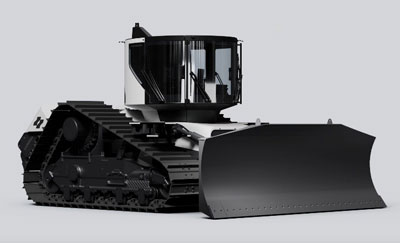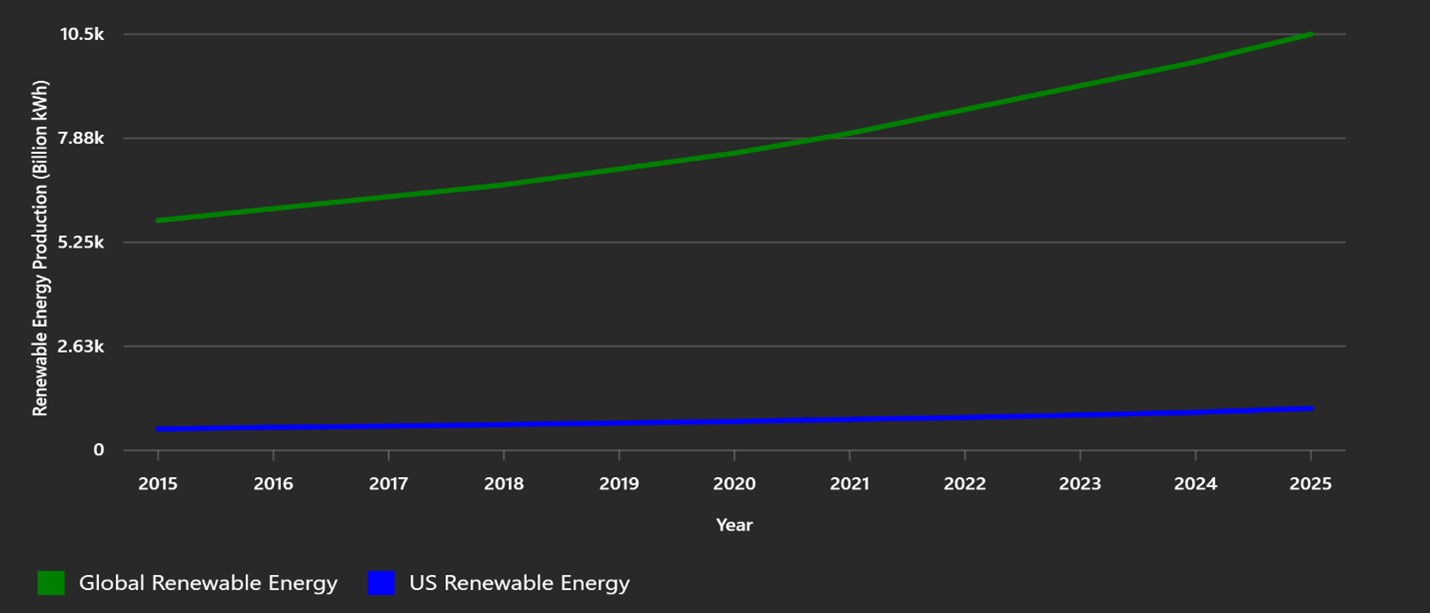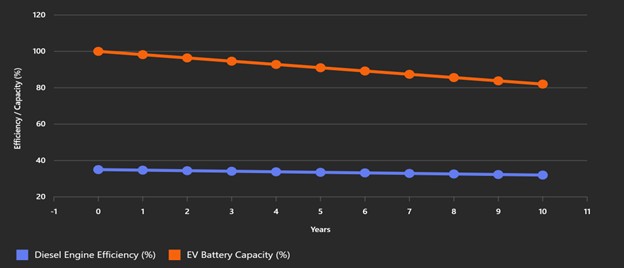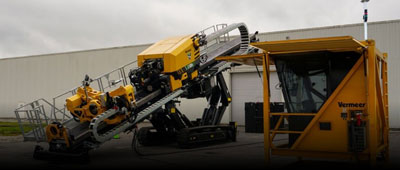Is the Future of HDD Electric?
By Bob Martin - Brand Manager, HDD Broker LLC - October 20, 2025
Horizontal Directional Drills are heavy, power-intensive machines. They're extracting massive amounts of dirt and rock each time they bore, and they're dropping in massive weights of product each time they pull back.
Since their inception in the 1970s, HDD equipment has traditionally relied on diesel engines driving hydraulics, and for good reason. Diesel engines have been around for over a hundred and twenty-five years, employed in vehicles and vessels since the early 1900's. While diesel engines have evolved with innovations like fuel injection and turbocharging, they are fundamentally utilizing the same principle of compression ignition that they first rolled out with.
Today, 'electric' has become a prominent buzzword, hitting the automotive industry with a vengeance in 2012 with the rollout of Tesla's all electric passenger car, the Model S. Today, electric vehicle sales make up 22% of all new cars sold worldwide and by the end of the year, one in four vehicles sold in the world will be electric.
Electrification is starting to be explored in other industries as well. Adoption in aviation is progressing rapidly, though full-scale implementation is still in its early stages. For example, Harbour Air out of Vancouver, BC, Canada is in the process of converting its entire fleet of aircraft to electric and aims to launch its first commercial electric flight by 2026. In agriculture, we have already seen the introduction of electric tractors and farm equipment such as the Monarch MK-V and Soletrac e25, with manufacturers like John Deere rolling out prototype machines in the 130hp size range very soon. Probably most aligned to the HDD industry, construction equipment is seeing adoption as well with models such as the Lumina ML6 electric bulldozer, which is the size of a D6 but pushes material like the much larger D9.
So, with all these examples becoming more and more commonplace, the fundamental question we need to address is whether or not electrification (battery, tethered electric, or hybrid) becomes the dominant paradigm, or at least a significant niche, for HDD in the coming decades.
Let's take a look at both sides of the issue:
Benefits of Electric Equipment
Efficiency
First, consider the core technology. Electric motors are undeniably more energy efficient. They have less waste heat and fewer mechanical losses than their internal combustion counterparts. The overall efficiency of a modern diesel engine is typically in the realm of 30 to 40%, with 60-70% of fuel energy lost as heat. Electric motors, on the other hand, are 85 to 95% efficient, with the vast majority of the electrical energy being converted to actual mechanical work.
Electric motors also only operate when needed, with no need to idle as their gas counterparts do, resulting in less wasted energy and unneeded wear on moving parts.
Electricity Costs
Next, consider the energy source for electric motors. As a rule, electricity is cheaper per unit of energy than diesel. If we look at things here in my location near Houston, TX, for example, we can come up with a raw cost of electricity per megajoule at $0.034 and about $0.023 for diesel. Diesel is about 30% cheaper! However, once you take into account the energy efficiency of the two technologies, you end up with a cost per of $0.038 for electricity and $0.066 for diesel. This makes diesel twice as expensive per usable megajoule.
Reliability
If you look at an electric motor, you have just two or three moving parts, those typically being the rotor and the bearings. That's it. Compare that to a diesel motor where you can have hundreds of moving parts. There are reliability equations that can quantify the likelihood of a breakdown of a system based on the number of parts it has. In the case of a directional drill, failure risk scales roughly linearly with part count, or to put it simply, doubling the part count also doubles the likelihood of any one of the parts failing.
Electric motors also come with a greater reduction in consumables such as filters and oil, all of which are additional costs associated with internal combustion motors.
Another benefit of this increased reliability is the actual longevity of the machine. Diesel and hydraulic components eventually wear out over time, and while electric components do not last indefinitely, one manufacturer I have spoken with estimates the lifetime of an electric drill to be between two and three times longer than that of its diesel counterpart.
Emissions
As electric motors are not forced to burn anything to create power, they create no localized emissions. This is highly important as countries begin intensive efforts to reduce emissions and create stricter regulations around them.
Detractors of electrification argue that a lot of power is currently generated through means that produce high levels of greenhouse gases, air pollutants, or environmental damage. That is certainly true, with fossil fuels still accounting for over 60% of global electricity generation. However, clean energy is becoming a larger and larger percentage of overall energy production around the world. According to the most recent data available, the US currently gets 21% of its energy from renewable sources. Renewable power generation is expected to increase by 12% in 2025 and another 8% in 2026, reaching 1,138 billion kWh. Some countries such as Norway, Uruguay and Iceland already get 100% of their energy from renewable sources, while our neighbors to the north in Canada are currently at 66%. These numbers are growing each year, with electricity becoming an increasingly clean option.
Other Considerations
Electric motors also integrate very well with sensors and control electronics, making the idea of increased automation and highly precise control much more feasible than with a standard hydraulic system. Full autonomy is also much easier to implement with a fully electric platform, which can help address labor and skill shortages.
Lastly, as the integration of electric power into heavy construction equipment gains traction, the costs associated with the early implementation of it will fall. Batteries will become more advanced, offering higher storage capacity with shorter recharge times, and electric power components and integration expenses will likewise drop as manufacturers build these processes into their manufacturing DNA.
Drawbacks to Electrification
Upfront Costs
Electric machines will cost more to purchase, lease or rent than a conventional HDD machine, at least for many years to come. There are investment costs that manufacturers need to attempt to recover, and there is always the 'early adopters surcharge' regardless of what you buy. Certainly, the operational savings in terms of reduced downtime and maintenance will offset this, but the break-even point will typically be higher than a diesel-powered drill. Recent data shows that it may take up to seven years for the cumulative cost of ownership of electric equipment to dip below their diesel counterparts.
Energy storage
True full-electric drills with onboard batteries are going to face a challenge in these early years. Battery technology currently struggles to support a full day of intense drilling, although some heavy construction equipment manufacturers such as Caterpillar are already advertising “full day on a single charge” capabilities for many of their electric heavy construction equipment models. For now, large battery capacity means large battery packs, which can be problematic to house within a directional drill's frame and can cause weight issues for transport and equipment staging.
Electricity Availability
For electric machines that are tethered electric (requiring an outside power source to function), access to electricity can play a massive role in the feasibility of deployment. The local grid may not have the capacity to supply the high power demands of a larger piece of equipment. Using a separate generator may address availability issues, but it negates many advantages that true electric offers as you run a large diesel motor and potentially run afoul of emissions regulations.
Unlike diesel refueling, battery recharging takes significantly longer. Charge rates and times must be carefully considered and scheduled to ensure no downtime due to depleted power on the machine.
Battery Downfalls
For use in construction equipment, batteries must be robust, durable and safe under harsh operating conditions. They are subject to vibration, temperature and shock that is not seen by equipment such as automotive passenger vehicles. These batteries will undoubtedly incur additional costs to meet operational standards.
Additionally, batteries are subject to eventual degradation in performance due to their chemical makeup. Diesel engine efficiency changes modestly over time. In contrast, while electric drivetrains keep their high conversion efficiency; what ages is the battery: capacity slowly declines (on the order of roughly 1.8%/year on average in large fleets) and internal resistance rises, which trims runtime and peak power under heavy loads.
Another huge consideration of batteries is what to do with them once they reach their operational lifespan. Less than 5% of lithium-ion batteries are currently recycled worldwide. Recycling capacity must increase 50-fold globally by 2035 to meet EV growth demands. New companies are cropping up constantly to address these challenges, but we're nowhere near being able to meet current demand for recycling.
Emissions
As the U.S. is a major consumer of HDD equipment, and with many of the main manufacturing companies for them being located here, emissions concerns do not play as large a role as it does in places like Europe where climate-related regulations have a larger focus from government agencies. Where European contractors may be forced to embrace the technology in order to undertake drilling contracts, American contractors lack that forced adoption and will, therefore, have less incentive to make the change.
Conclusion
We are already seeing the new breed of electric drills entering the market. The Vermeer D120E was a machine that I was fortunate enough to have seen in person at the recent Bauma Expo. Earlier to market is the Herrenknecht HK300TE all-electric and their HK80CK hybrid electric drills. Manufacturers have identified the need to produce electric options and are shifting resources to allow them to research and implement new electric drill platforms.
The answer of whether electrification is going to play a major role in the HDD industry is not a simple one. There is a myriad of considerations based on where the equipment will be working, the size of the machine in question, and, perhaps most importantly, the appetite of a contractor to be one of the first adopters of a relatively new breed of HDD machines.
Perhaps we can agree that ultimately, electrification is inevitable. The benefits are too great, and the technology increasing too quickly to think differently. In the years to come, more and more contractors will be willing to explore owning electric equipment as prices for it drop and use cases increase.
But switching is not trivial: technical, economic, operational, and infrastructure issues all play a role. Any long-term change toward electric will not be instantaneous. Fleets will be a mix of traditional diesel and electric machines for many years to come. Just as a Mini Cooper isn't suited for hauling bricks or a Ferrari for a large family, you would not buy an electric drill if you don't have access to the electric infrastructure to support it, or jobs that align with the size of electric machines available. There are use cases where they will excel, and some where they will not make sense.
Internal combustion engines will eventually be phased out. The big question is when that will be, and what role contractors want to play in that change, either as early adopters of new technology, cautious observers of it, or as staunch opponents against it.

This commentary is presented for informational purposes only. It is not intended to be a comprehensive or detailed statement on any subject and no representations or warranties, express or implied, are made as to its accuracy, timeliness or completeness. Nothing in this commentary is intended to provide financial, legal, accounting or tax advice nor should it be relied upon. Neither HDD Broker LLC nor the author is liable whatsoever for any loss or damage caused by, or resulting from, any use of or any inaccuracies, errors or omissions in the information provided.






